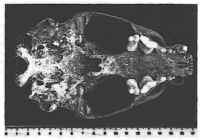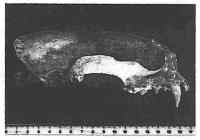 |
Last Update:
Thursday November 22, 2018
|
| [Home] |
|
Volume 17 Pages 1 - 58 (April 2000) Citation: Beccaceci, M.D. & Waller, T. (2000) Presence of the Giant Otter, Pteronura brasiliensis, in the Corrientes Province, Argentina IUCN Otter Spec. Group Bull. 17 (1): 31 - 33 Presence of the Giant Otter, Pteronura brasiliensis, in the Corrientes Province, Argentina Marcelo D. Beccaceci1 and Tomás Waller2 1IUCN/SSC
Veterinary Specialist Group. Jacinto Diaz 114. San Isidro (1642 Buenos
Aires. Argentina. E-mail: iucnvet@wamani.apc.org
On April 19th, 1999, ranger Domingo R. Cabrera collected a giant otter (Pteronura brasiliensis) skull half-submerged in the little "Biombo" island, situated at Fernández lake, Iberá Natural Provincial Reserve, Mercedes Department, Corrientes (28° 37' LS - 57° 32' LW). The skull lacks the lower jaw but it is well preserved with only one upper canine tooth missing. Although it was not dated it looks several decades old. The specimen has been deposited at the mammalian collection of the Museo de Ciencias Naturales de La Plata, Buenos Aires (MLP1811993). Measurements were made on the skull as follows (in mm):
The former distribution of the species in Argentina was the Uruguay and Paraná river catchments, with populations in the Mesopotamia region, the Eastern Humid Chaco, and the subtropical rainforests of Misiones province (FOSTER-TURLEY et al., 1990). The last known references for Corrientes province came from foreign travellers and they are over a hundred years old. However, the presence of the species in the area was mentioned until 1993 by fishermen and hunters along the Paraná river (BECCACECI and GARCÍA RAMS, 1995). Regarding the Iberá Marshes, largest wetland in Argentina with 1,300.000 ha, data from the local people mentioned the existence of some few giant otters by the end of 1930's (BECCACECI and GARCÍA RAMS, 1995). Until this finding, there was no biological material collected as an evidence of the former distribution of the species in this province. ACKNOWLEDGEMENTS - We are grateful to ranger of the Iberá Natural Provincial Reserve, Domingo R. Cabrera, the Institute de Medio Ambiente y Ecología (IMAE) of the Universidad del Salvador (USAL), Argentina, and the Universitá di Siena, Italy. REFERENCES Beccaceci, M.D. & García Rams, M.
(1995). Comentarios sobre la extinción de grandes mamíferos
correntinos en la segunda mitad del siglo XX. Resúmenes X Jornadas
Argentinas de Mastozoología, pp.6-7. Sociedad Argentina para el Estudio
de los Mamíferos, La Plata, Argentina. RESÚMEN: Presencia
de la Nutria Gigante, Pteronura brasiliensis, en la provincia de
Corrientes, Argentina La distribución pasada de la especie en la Argentina comprendía las
cuencas del río Uruguay y del Paraná, con poblaciones en la región de
la Mesopotamia, el Chaco Húmedo Oriental y las selvas subtropicales de
la provincia de Misiones (FOSTER-TURLEY et al.,
1990). Las ultimas referencias para la provincia de Corrientes
provienen de viajeros extranjeros y tienen más de cien años de
antigüedad. Sin embargo, la presencia de esta especie en la zona fue
mencionada hasta 1993 por Pescadores y cazadores a lo largo del río
Paraná (BECCACECI y GARCÍA RAMS, 1995). Con
respecto a los esteros del Iberá, el mayor humedal de la Argentina con
1.300.000 has, informaciones de los pobladores locales mencionan la
presencia de algunas nutrias gigantes hacia fines de la dácada del '30
(BECCACECI y GARCÍA RAMS, 1995). Hasta este
hallazgo, no existía material biológico colectado que evidenciara la
pasada distribucidn de la especie en la provincia. |
| [Copyright © 2006 - 2050 IUCN/SSC OSG] | [Home] | [Contact Us] |

